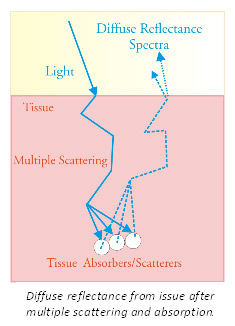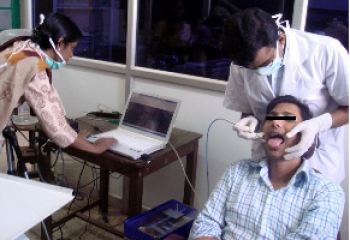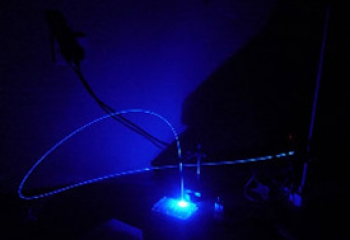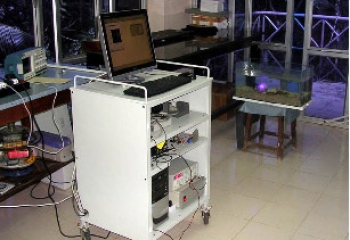
Biophotonics Laboratory (BPL)
Biophotonics is an emerging sector of scientific convergence, integrating the application of optical sciences and technologies to life science and clinical medicine. An increasing number of scientific discoveries occur at the boundaries of traditional academic disciplines through interdisciplinary collaborations that advance the frontiers of science. Research conducted under the umbrella of biophotonics in CESS falls in the border zones of physics, biology and medicine.
 The interaction of light with matter is interesting as well as perplexing when we perceive closely. Light is essential for all forms of life within the biosphere and it is the ambient light that supports photosynthesis in plants and many photochemical and photobiological reactions in the human body. Application of optical spectroscopy techniques to life sciences research were initiated in 1992 through a research program funded by the Council of Scientific & Industrial Research (CSIR) to study nutrient and water stress in plants by the Laser-induced Fluorescence (LIF). The successful completion of this project led to initiation another program to study the impact of automobile pollution in medicinal and crop plants of Kerala funded by the STED, Govt of Kerala.
The interaction of light with matter is interesting as well as perplexing when we perceive closely. Light is essential for all forms of life within the biosphere and it is the ambient light that supports photosynthesis in plants and many photochemical and photobiological reactions in the human body. Application of optical spectroscopy techniques to life sciences research were initiated in 1992 through a research program funded by the Council of Scientific & Industrial Research (CSIR) to study nutrient and water stress in plants by the Laser-induced Fluorescence (LIF). The successful completion of this project led to initiation another program to study the impact of automobile pollution in medicinal and crop plants of Kerala funded by the STED, Govt of Kerala.
Sensing the vast potential of optical spectroscopy techniques in the healthcare sector, a major project was initiated to develop and test a portable “optical biopsy” device for non-invasive detection oral malignancy, in collaboration with Regional Cancer Centre (RCC), Trivandrum, with support from the Department of Science & Technology, Govt. of India.
Oral cancer is a disease that affects millions of people across the globe and the number of patients is on the rise. India accounts for a third of the world burden of oral cancer. During transformation towards malignancy it is known that tissue composition, its morphology and vascularity gets altered. We noticed that in addition to changes in the laser-induced autofluorescence (LIAF) characteristics of tissues, the diffuse reflectance spectra gathered from spatially distant points from the incident beam showed effects of multiple scattering and absorption. We proposed that the intensity ratio of oxygenated hemoglobin absorption dips at 545 and 575 nm in the diffusely reflected tungsten halogen spectra of tissues could be used to detect early symptoms of tissue transformation towards malignancy.
 This led to the development of a Laser-induced fluorescence and reflectance spectroscopy (LIFRS) point monitoring system, which was tested through clinical trials to detect different stages of oral cancer, including premalignant stages, with the help of SRRS algorithms developed to categorize lesions. The LIFRS instrument built was also found useful for investigating plant stress, coral health, detection of dental caries and tooth demineralization. These studies have led to the development of multi-spectral imaging systems for studying corals, vegetation and cancer. At present the laboratory focuses on:
This led to the development of a Laser-induced fluorescence and reflectance spectroscopy (LIFRS) point monitoring system, which was tested through clinical trials to detect different stages of oral cancer, including premalignant stages, with the help of SRRS algorithms developed to categorize lesions. The LIFRS instrument built was also found useful for investigating plant stress, coral health, detection of dental caries and tooth demineralization. These studies have led to the development of multi-spectral imaging systems for studying corals, vegetation and cancer. At present the laboratory focuses on:
Collaborating Institutions:
- Insitute of Electronics, Bulgarian Academy of Sciences, Sofia, Bulgaria
- Regional Cancer Centre, Trivandrum
- Govt: Dental College, Trivandrm
- Rajiv Gandhi Centre for Biotechnology, Trivandrum
- Azzezia Dental College, Kollam
- M/s. Vinvish Technolgies Pvt Ltd, Technopark, Trivandrum
- M/s. Innobreeze Technologies, Trans Asia Corporate Park, Kakkanad, Kochi
Instruments Developed:
- LIFRS system for point monitroing of oral cavity cancer
- LIMFIS for laser-induced active remote sensing of corals
- Multi-spectral EMCCD camera system for fluorescence and reflectance imaging
Facilities Available:
- Nitrogen Laser (Spectra Physics, USA, model: VSL-337) with 30KW peak power, 4ns pulse width, 0.1 nm bandwidth, rep rate: up to 20 Hz, 120 µJ /pulse at 337 nm
- Nitrogen laser pumped Dye laser (Spectra Physics Model: DYE 110) with 360-950 nm tunable, 3 -10 nm bandwidth).
- DPSS 457 nm Deep Blue Laser, 200 mW (Shanghai Dream Lasers, PRC, Model: SDL-457-200T)
- Fiber Coupled Diode lasers with 1 W, CW power @ 635 nm and 655 nm (CNI Optoelectronics Tech, PRC)
- Miniature Fiber-optic Spectrometer (Ocean Optics USA, Model; USB2000FL) with Tungsten halogen source (Ocean Optics USA, Model; LS-1-LL), fiber-optic probes and fiber adapter kit and accessories.
- Intensified CCD Camera (Andor Technology, Ireland, Model: DH734-18-FO3)
- Liquid Crystal Tunable Filters (Cambridge Research Instrumentation , USA, Models:VIS-20-20 and VIS-7-20)
- Electron Multiplying CCD (EMCCD) camera (Andor Technology, Ireland, Model: LUCA-R-DL-604)
- Hand-held portable Photosynthesis System (CID Inc, USA, Model:CI-340)




 RTI Act
RTI Act


